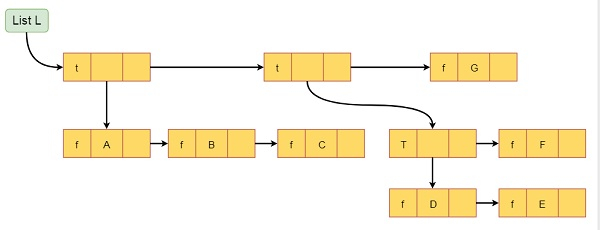
 Data Structure
Data Structure Networking
Networking RDBMS
RDBMS Operating System
Operating System Java
Java MS Excel
MS Excel iOS
iOS HTML
HTML CSS
CSS Android
Android Python
Python C Programming
C Programming C++
C++ C#
C# MongoDB
MongoDB MySQL
MySQL Javascript
Javascript PHP
PHP
- Selected Reading
- UPSC IAS Exams Notes
- Developer's Best Practices
- Questions and Answers
- Effective Resume Writing
- HR Interview Questions
- Computer Glossary
- Who is Who
Generalized Lists in Data Structure
In this section we will see the generalized lists. The generalized list can be defined as below −
A generalized list L is a finite sequence of n elements (n ≥ 0). The element ei is either an atom (single element) or another generalized list. The elements ei that are not atoms, they will be sub-list of L. Suppose L is ((A, B, C), ((D, E), F), G). Here L has three elements sub-list (A, B, C), sub-list ((D, E), F), and atom G. Again sub-list ((D, E), F) has two elements one sub-list (D, E) and atom F.
In C++, we can define the Generalized list structure like below −
class GeneralizedListNode{
private:
GeneralizedListNode *next;
bool tag;
union{
char data;
GeneralizedListNode *down;
};
};
So if the tag is true, then element represented by the node is a sub-list. The down points to the first node in the sub-list. If tag is false, the element is atom. The next pointer points to the next element in the list. The list will be look like this.


